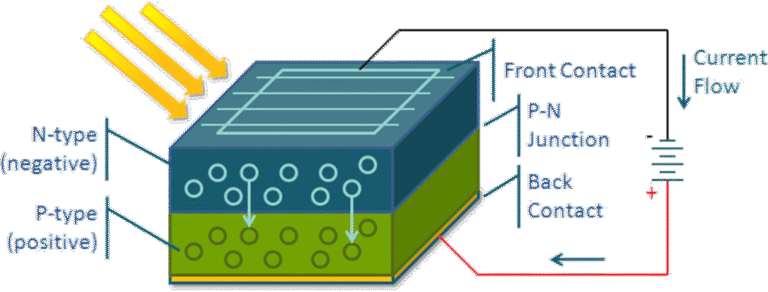🌍 Global Contribution of Renewable Energy
As of 2024, renewable energy accounts for over 30% of global electricity generation, with solar PV contributing nearly 11%. The rapid fall in solar panel costs, supportive policies, and climate goals are driving large-scale adoption.
| Source | Global Share (2024) |
|---|---|
| Solar PV | ~11% |
| Wind | ~9% |
| Hydro | ~8% |
| Biomass & Others | ~2% |
⚙️ How a PV Power Plant Works
Solar PV plants convert sunlight into electricity using the photovoltaic effect. Here’s the basic flow:

- Sunlight hits PV panels, exciting electrons.
- DC electricity is generated.
- Grid-Tied Inverter (GTI) converts DC to AC.
- Power is synchronized and fed into the utility grid.
Irradiance at the Site
•Beam Radiation – solar radiation received from the Sun without being scattered by the atmosphere and propagating along the line joining the receiving surface and the sun. It is also referred as direct radiation. It is measured by a pyrehiliometer.
•Diffuse Radiation – the solar radiation received from the Sun after its direction has been changed due to scattering by the atmosphere. It does not have a unique direction and also does not follow the fundamental principles of optics. It is measured by shading pyrenometer.
•Total Solar Radiation – the sum of beam and diffused radiation on a surface. The most common measurements of solar radiation is total radiation on a horizontal surface often referred to as ‘global radiation’ on the surface. It is measured by pyrenometer.
🔌 PV System Configurations
| Type | Description |
|---|---|
| Grid-Tied | Connected to utility grid, no battery storage. Most common in large-scale. |
| Off-Grid | Uses batteries, suited for remote locations. |
| Hybrid | Mix of grid + storage; balances intermittency. |
| Floating PV | Installed on water bodies to save land. |
🏗️ Key Equipment in Utility-Scale PV Plants
- Solar Panels (Modules)
- Monocrystalline, Polycrystalline, or Thin-Film
- High-efficiency panels reach 20–23%
- Grid-Tied Inverters (GTI)
- Converts DC to AC with MPPT tracking
- Synchronizes with grid voltage & frequency
- Combiner Boxes & Cables
- Aggregates panel outputs, ensures protection
- Transformers & Switchgear
- Step up voltage to grid-level; ensure safe dispatch
- SCADA & Monitoring Systems
- Real-time control, performance analysis
- Mounting Structures (Fixed/Tilt/Tracking)
- Optimizes angle of incidence for maximum irradiance
🔋 PV Panels: The Heart of the System
- Monocrystalline: High efficiency, premium price
- Polycrystalline: Cost-effective, slightly lower efficiency
- Thin-Film: Flexible, lower output but ideal for space-constrained or mobile setups
🔄 Grid-Tied Inverters (GTIs)
GTIs are the brains of PV systems:
- Function: DC-to-AC conversion + grid synchronization
- Types: Central, string, micro-inverters
- Features: Anti-islanding protection, MPPT tracking, remote diagnostics

✅ Pros and ❌ Cons of Solar PV Power Plants
| Pros | Cons |
|---|---|
| Clean, renewable, zero emissions | Weather-dependent & intermittent output |
| Low O&M costs after installation | Land-intensive for large-scale systems |
| Scalable from kW to MW | Efficiency affected by dust/shading |
| Government incentives & subsidies | Needs high upfront investment |
📊 Efficiency of Solar PV Power Plants
- Panel Efficiency: 18–23%
- System Efficiency (after losses): ~15–18%
- Loss Factors:
- Soiling
- Inverter losses
- Cable & transformer losses
- Temperature coefficient
Summary
•Cost reductions available through design, material specification, and construction techniques developed by the power industry in response to the need for lower-cost traditional generating stations can effect significant cost savings when applied to PV generation systems. Higher generation through the proper design and use of efficient system components effectively means lower cost of power.
•Some critical factors that must be kept in mind during design include proper
•selection of modules, optimum angle of tilt, minimization of ohmic losses with proper
•selection of conductors, selection of efficient transformers and inverters etc. Use of
•Reliable and long-life components is equally essential for expensive solar power plants.


